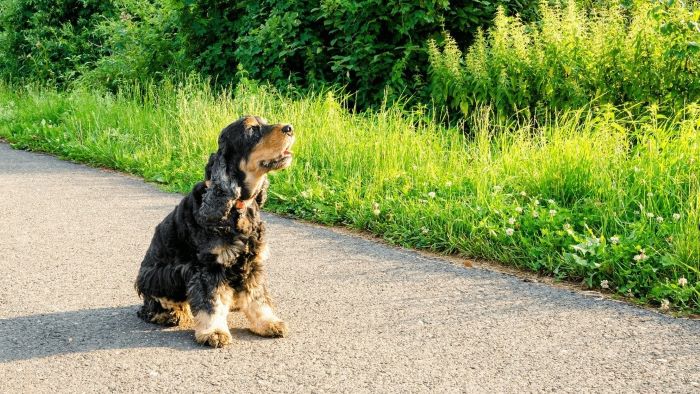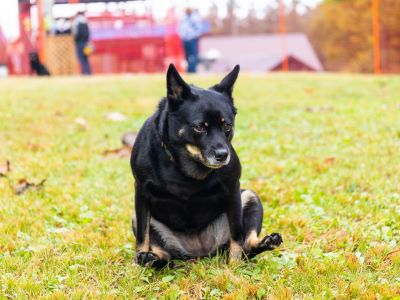It’s common for dog owners to see their dogs indulging in a peculiar activity, but what is scooting? why do dogs scoot?

While it may be amusing or embarrassing, dog scooting can be due to some underlying condition. But hey, don’t worry we are here to save the day!
In this blog, we are going to understand what is dog scooting, the reasons behind this behaviour and what can we do to help our dogs. Stay tuned to learn it all.
Why Do Dogs Scoot?
In scooting dogs sit down and start dragging their bottom across the floor, whether it’s the the grass in the park or their old favourite living room carpet.
Dogs often scoot because they are trying to get rid of something at the bottom. It’s their way of saying something needs attention back there. Let’s learn some of the causes of dog scooting:
1. Blocked Anal Sacs
Dogs have tiny sacs on either side of their backside that usually empty naturally when they poop. Sometimes, these sacs can get blocked, causing discomfort. To relieve the itchiness, dogs might scoot.
If these anal sacs become clogged or infected, it creates pressure and irritation. Scooting is your dog’s attempt to empty the sacs and relieve discomfort.
"Anal glands can become uncomfortably full for dogs. This is common in small breeds like Chihuahuas and Poodles, but any dog can be affected", confirms Dr Michael Kearley at PetMD.

In rare cases, abnormalities like tumours or cysts on the anal glands can develop and cause scooting. A vet’s care is needed to diagnose and treat these growths.
2. Skin Irritation
Sometimes, dogs may have irritation or even allergies that affect their bottom area. Scooting can be a sign of inflamed skin or allergies around the rear and anal area.
Food allergies or sensitivity to grooming products may cause itchy skin that leads to scooting. Yeast infections and poor hygiene can also irritate the skin.
3. Food Allergies
Food allergies can cause irritation in dogs to relieve that dogs may try to scoot.

If they eat something that doesn’t agree with them, it can lead to skin problems and scooting. Diet change may relieve the allergies.
4. Stomach Issues
If a dog has an upset stomach or gastrointestinal problems, it can lead to scooting. The discomfort from these issues can make them want to relieve the pressure by scooting.
Worms like tapeworms and roundworms in the digestive tract can migrate and cause itching around the anus, resulting in scooting[1]. Keeping your dog on monthly parasite prevention can help avoid this.
What Should You Do if You See Your Dog Scooting?
If you notice your dog scooting, it’s a sign that they might be going through discomfort or an underlying issue. Here’s what you should do:
- First, inspect your dog’s bottom to see if there are any obvious signs of irritation, redness, or swelling around the rear, tail, or anal area. Be gentle and look for anything unusual.
- If you see any signs of irritation or if your dog continues to scoot, it’s essential to consult your vet. They can perform a thorough examination to determine the cause of the scooting.
- If clogged anal sacs are the issue, your vet can express them. You should never attempt this at home, as it can be uncomfortable for your dog and should be done by a professional.

- If skin irritation or allergies are causing the scooting, your vet can recommend a treatment plan, which may include special shampoos, medications, or dietary changes.
- If food allergies are suspected, your vet may suggest a diet change. Ensure you follow their guidance and avoid feeding your dog any known allergens.
Remember, scooting is a sign your dog needs help. Contact your vet!
Treatment for Dog Scooting
If clogged anal sacs are the issue, your vet can perform anal gland expression. Don’t try this at home, as it should be done by a professional. Your vet might prescribe medications to relieve itching, inflammation, or allergies that could be causing the scooting.
Keep the affected area clean and dry. Gently clean with a pet-friendly, non-irritating solution recommended by your vet. Follow your vet’s advice on diet modifications if food allergies are suspected.
Add 1-2 tablespoons of Epsom salt to a warm bath to reduce swelling and relax muscles. If your dog is still scooting or you notice more symptoms then consult your veterinarian for a proper diagnosis and treatment plan.
Home Remedies
Let’s see some home remedies that may help in the dog scooting:
- Gently wash the irritated area with mild soap and water to keep it clean. Rinse and dry entirely.
- An oatmeal bath can soothe irritated skin. Add a cup of colloidal oatmeal to a warm bath and let your dog soak for 15 minutes. Feeding canned pumpkin may also help[2].
- Apply a cool, wet cloth to swollen or inflamed areas to reduce discomfort. The cooling gel from an aloe plant can provide relief when applied to irritated skin. Apply virgin coconut oil to the affected area to moisturize, reduce inflammation and promote healing.

Prevention of Dog Scooting
Feed your dog a balanced diet to promote overall health and reduce the risk of allergies or stomach problems. Maintain cleanliness by regularly bathing and cleaning your dog’s rear end.
Identify and eliminate potential allergens in your dog’s environment, such as certain cleaning products or pollen. Regular exercise helps maintain a healthy digestive system and overall well-being. Prevent skin folds and irritation by keeping your dog at a healthy weight.
Have regular wellness checks to diagnose and address any problems early. Do not ignore any signs and schedule routine vet visits to address any potential issues quickly.
FAQs
1. How Do I Stop My Dog From Scooting?
Boil some water and let it cool to a warm but comfortable temperature. Soak a clean cloth or gauze in the warm water and wring out the excess. Gently apply the warm compress to your dog’s anal area for a few minutes. Repeat this process a few times a day to help alleviate discomfort.
2. What Food Stops Dogs From Scooting?
When it comes to the best dog food for anal gland issues, it’s clear that high-fibre options are preferred. Fibre promotes better overall gut health, which supports healthy anal gland function––and can help put a stop to your dog’s scooting!
3. Why Do Dogs Scoot?
They can often become full to the point of being uncomfortable. This is common for smaller breeds such as Chihuahuas, Miniature Poodles, and Shih Tzus, but all dog breeds can be affected. Scooting is often a normal response to having an itchy rear end, which is usually due to full anal glands.
4. Does Dog Scooting Go Away on Its Own?
Regardless of the cause, ignoring the problem will not make it go away. In fact, whatever the issue, it is likely to get worse. Although it is extremely rare, in some cases ignoring the scooting can be very dangerous for your pet if it ends up being a cancerous tumour or infected anal gland.
Summary
In conclusion “Why do dogs scoot?” They do this in order to feel comfortable down there. Scooting may be due to many reasons like blockage and irritation, we must address these issues quickly.
There are many treatment and prevention options available to help our dogs scratch-free (pun intended) from this situation and lead a happy and healthy life!
Reference:
- Why do dogs scoot? Their behaviour explained | Purina.
- Nelson, J. (2023, October 4). Why is my dog scooting? American Kennel Club.



